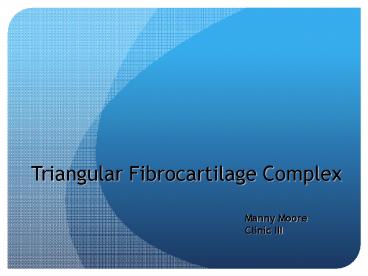Adolescent Concussion - PowerPoint PPT Presentation
1 / 18
Title:
Adolescent Concussion
Description:
Open Dissection, Arthroscopy,or Direct Repair Central Tears Peripheral Tears Preoperative ... Triangular Fibrocartilage Complex (TFCC) Repair and Rehabilitation. – PowerPoint PPT presentation
Number of Views:38
Avg rating:3.0/5.0
Title: Adolescent Concussion
1
Triangular Fibrocartilage Complex
Manny Moore Clinic III
2
Triangular Fibrocartilage Complex
What Structures are Involved
- Anatomy?
- Stability?
- Mechanism of injury?
- Predisposing Factors?
3
Injury Assessment
- History
- Inspection
- Palpation
- Range of Motion
- Neurological Testing
- Special Test
4
Nonoperative versus Operative Management
- Conservative Treatment Guidelines
- Rest
- Avoid Stressful Motions
- Rehabilitation
- Splints or brace
- NSAIDS
- Surgical intervention is suggested if the patient
symptoms are not alleviated - Within 4-6 weeks depending on the type of lesion.
Refer out for Imaging
5
- Palmer Classification for TFCC Lesions
- Traumatic Lesions
- Class IA Central rupture
- Class IB Ulnar avulsion with/without disruption
of the ulnar styloid - process
- Class IC Distal avulsion
- Class ID Radial avulsion with/without osseous
lesion of the radius - Degenerative Lesions
- Class IIA Superficial degenerative lesion
- Class IIB Degenerative tear with cartilage
lesion of the lunate or the ulna - Class IIC Degenerative disc perforation with
cartilage lesion of the lunate - or the ulna
- Class IID Degenerative disc perforation with
cartilage lesion of the lunate - or the ulna and lunotriquentral instability
- Class IIE Degenerative disc perforation with
cartilage lesion of the lunate
6
Diagnostic Imaging
- MRI?
- CT Scan?
- Arthroscopy?
The Golden Standard?
7
- Which Surgical Procedure?
- Open Dissection, Arthroscopy,or Direct Repair
Deciding Factors?
- Central Tears
- Peripheral Tears
- Ulnar Varience
Goals?
- Preoperative Rehabilitation?
- Postoperative Rehabilitation?
8
Phase I for Central Debridement (3-5 days)
- Goals
- Control edema
- Pain
- Protect repair
- Minimize deconditioning
- Intervention
- Remove post-op dressing
- Edema control with light compressive dressing
to hand and forearm - Active ROM exercises for wrist and forearm are
begun 4-8 times a day - A wrist splint is fabricated to wear between
exercises and at night
9
Phase II for Central Debridement (10-14 days)
- Goals
- Control edema
- Pain
- Continue to protect repair
- Minimize deconditioning
- Scar management
- Intervention
- Scar management begun within 48 hours of suture
removal - Initiation of active-assist ROM for wrist and
forearm
10
Phase III for Central Debridement Weeks 3-4
- Goals
- Control edema
- Pain
- Improve ROM
- Intervention
- Passive ROM of wrist and forearm may be
initiated - Dynamic wrist splinting may be begun to improve
ROM - Weighted wrist stretches may be initiated
also to increase ROM
11
Phase IV for Central Debridement Week 6
- Goals
- Continue with ROM gains
- Begin strengthening
- Intervention
- Progressive strengthening may be begun using
putty or a hand exerciser - The wrist immobilization splint may be
discontinued if the patient is asymptomatic
12
Phase I for Peripheral Repair (Week 1)
- Goals
- Edema control
- Protect repair
- Intervention
- Patient remains in bulky post-op dressing
- Instructions in edema control
13
Phase II for Peripheral Repair (Week 2)
- Goals
- Edema and pain control
- Continue to protect repair
- Intervention
- Removal of bulky dressing
- Edema control with retrograde massage, Isotoner
glove, and/or coban wrapping - Daily pin care as needed
- Long arm cast with 90 elbow flexion and wrist
in neutral or wrist cock-up splint - fabricated
- Active and passive ROM for wrist and digits,
include tendon glides (lumbrical grip, hookfist,
full fist) - Isometric exercises for forearm/hand 10
repetitions 4 times/day - Low-grade isotonic exercises can be initiated
if edema is not present (i.e., lightest putty) - Light ADLs with 5 pound limit
14
Phase III for Peripheral Repair (Week 3-6)
Goals Edema Pain Increase ROM Scar
management Improve strength Intervention
Scar management with massage, scar pad
Discontinue splint (unless patient is still
symptomatic) Increase isotonic exercises up to
10 pounds maximum for upper arm, forearm Wrist
mobility/weighted stretches with less than 5
pounds 3-4 times/day ADLs with less than 10
pounds
15
Phase IV for Peripheral Repair (Week 8)
- Goals
- Continue to improve ROM
- Continue to increase strength
- Simulate work requirements
- Intervention
- Dynamic splinting as necessary to increase ROM
- Progress strengthening with putty, hand
exerciser, free weights - Simulate work tasks as able
Precautions
- Aggressive PROM or Strengthening that increases
pain - Increased ulnar-sided wrist pain
- If ulnar shortening in addition to the TFCC
repair or Debridement, - the course of post-operative therapy will be
altered.
16
Conclusion
- Rehabilitation ranges from 6-8 weeks depending
- on surgical methods used
- Arthroscopic and debridment is successful in
acute and chronic lesions, however chronic
lesions are more successful with ulna shortening. - Arthroscopy is still considered the golden
standard when diagnosing lesions and has showed
success in pain management function and stability
in TFCC repairs. - Despite its high sensitivity of MRI detecting
TFCC lesions MRI has its limitations in the
detection of peripheral TFCC tears.
17
References
Usama Albastaki, MD," Dimitris Sophocleous, MD,
Jan Gothlin, MD, PhD. MRI Imaging in TFCC
injuries. Journal of Munipulotive and
Physiological Therapeutics Volume 30, Number
7 Jui Tien Shih, Huung Maan Lee. Functional
Results of TFCC. Department of Orthopedics and
Hand Surgery, Vol 10, 2005 169-176. Cuong Pho
DPT, Joe Godges DPT. Triangular Fibrocartilage
Complex (TFCC) Repair and Rehabilitation. Indiana
Hand Therapy Protocols Jan-Ragnar Haugstvedt and
Torstein Husby.RESULTS OF REPAIR OF PERIPHERAL
TEARS IN THE TRIANGULAR FIBROCARTILAGE COMPLEX
USING AN ARTHROSCOPIC SUTURETECHNIQUE. Journal of
hand Surgery 1999.
18
?
Questions































